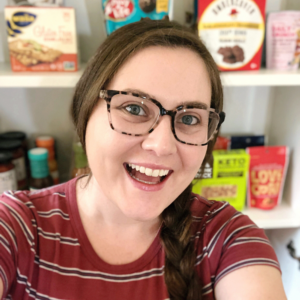Write Blog Posts that Rank on Google’s 1st Page
RankIQ is an AI-powered SEO tool built just for bloggers. It tells you what to put inside your post and title, so you can write perfectly optimized content in half the time. RankIQ contains a hand-picked library with the lowest competition, high traffic keywords for every niche.
Blog Title: Food Blog Usability
Social Media:
IG: https://www.instagram.com/cadiamarketing/
FB: https://www.facebook.com/cadiamarketing/
About: I help food bloggers be awesome by taking a deep-dive into the hows and whys of communicating and connecting with their followers. I especially focus on the concepts around user experience design and how to make blog user-friendly. I have a background in web design, digital content, marketing and management.
Notes from Episode #067: Adding HEART To Your Site To Improve The UX
Fun fact: Bethany used to work as a sports reporter – worked for an online newspaper in Portland, OR before SEO was a thing.
You must use the UX to really think through what you’re offering and how that goes beyond getting ad revenue. It’s important to broaden the picture because you don’t have control over it.
A ‘Jump To Recipe’ button is a great tool to cater to different types of users; one might just want the recipe, another might have specific questions about making the recipe but is not needing to read the recipe ingredients again.
Your website/blog should be the backbone of what you are but there are other things you should be doing to diversify what you’re doing.
HEART – this came from Google not as an algorithm but to help understand how we should be thinking about the UX.
Google has other products other than “search” functionality. It’s important to remember that too!
It’d be beneficial to think about what your core message is.
Happiness – How do people feel when they are using your site or products? Is it visually appealing? Does it feel professional? Making sure your colors and fonts work well. Use tools like Hot Jar to see how people are using your site. Make your users feeling good when they visit and aren’t lost looking for things.
Engagement – Do people click to another page on your site? Are they looking at your About page or do they view other recipes and spend more time on your site? Related links are good at this. You can encourage rating a recipe or commenting on the recipe – adding a picture. Ask them to “remember to make a comment” after making the recipe is ok but maybe asking them to go to another platform can be tricky, time consuming.
Adoption – How are you being found? SEO, Pinterest, social media sites
Retention – this isn’t well done in the food blogging world. The app, Prepear, is a good start. It allows someone to save your recipe and not have to return to the site to go through pages of crawling to get to the recipe card again. If someone joins you from Google, what’s next for them? Email is a good option. Hopefully they’ll like you on socials. Your site needs strong calls to action to start retaining the people you are bringing in. Think about the freebie as an option or the placement of how someone can sign up for more from you. You don’t have to give everyone ALL the options either. If you don’t do much on Facebook but are always on Instagram, then maybe only offer that link on your website – focus on driving people to one spot.
Task Success – what is the user trying to accomplish? If it’s ultimately to make a recipe, can they find the recipe? Can they find the recipe card? Is it easy to read visually – does it stand out? Is it printable? Does your site navigate easily? Can they get to the recipe easily or use a search bar on your site? There’s a scoping of the recipe so the user hasn’t committed to make it so finding it is important.
Prepear – this is a good forum for the user to find recipes, save them and be able to return back to it. But it also rewards the food blogger. So this should be seen as an extension of your blog and a good way to build UX rapport with your user.
Come up with a plan where you don’t function only to rank on search engines. Think through how to monetize in multiple ways but in a way that ultimately continues to grow your audience and connect with them more.
Something to think about: If Google and Pinterest didn’t exist, how would you make money?
Don’t try to do “everything” over the next month or two. Pick a task and work towards that for a bit – something within Retention is a good place to start.
Bethany offers full and mini audits for websites if you need some help working on this (see details below)!
Helpful references from the episode:
Resources on user experience design (UX):
https://www.responsinator.com/ – plug in your URL and see your mobile devices from a different perspective.
Book: Don’t Make Me Think by Steve Krug
More on website text scanning patterns (like the F pattern):
Text Scanning Patterns: Eyetracking Evidence
Site Audits:
Learn more about a full or mini site audit!
My Blog:




